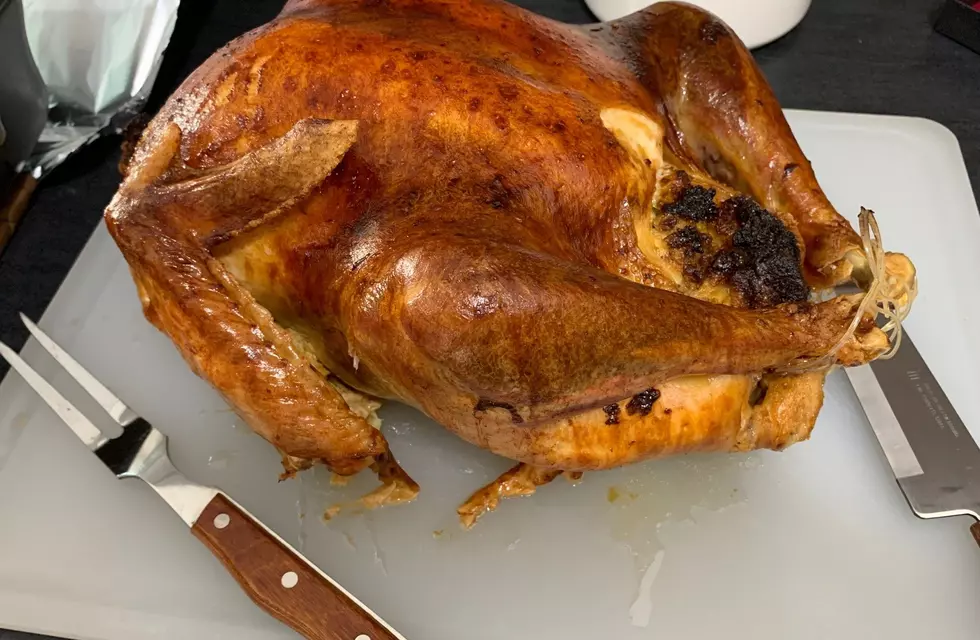
Chelan Douglas County Extension: Tips For a Safe Thanksgiving Meal
It's almost Thanksgiving and perfect timing to have Margaret Viebrock, Ccounty Director with WSU Extension in Chelan and Douglas County to explain important food safety during the holiday.
Let's start with defrosting the turkey. It's important to be aware how far out from Thanksgiving Day you may have to start to defrost that bird safely. Viebrock explains a simple formula, if you've got a frozen bird.
"If you're buying frozen bird, it takes five pounds every 24 hours to thaw if you're throwing it in the refrigerator" says Viebrock who is a 50 year veteran of consumer sciences with WSU. She says if you're running a little behind on that schedule, for instance a 20 pound bird would need to defrost 5 days in the refrigerator, then you can defrost the packaged turkey in a sink filled with cold water. However, Viebrock stresses to safely defrost the turkey in this manner, you must change the water every 30 minutes and keep it cold. The risk of defrosting a turkey in the sink is keeping the water bath chilled to around 40 degrees. Any warmer temperature will allow for bacteria to start to grow. If you are able to thaw your frozen turkey in time for Thanksgiving Day preparation or whenever you plan to roast the bird, it can safely remain thawed in your refrigerator for two to three days.
So what if you don't have enough time to thaw a frozen turkey in time for Thanksgiving preparation?
Consider buying a fresh bird. Some families are buying chickens or chicken or turkey breasts. Viebrock points out if there is no need for leftovers, or just the cost of Thanksgiving menu items. A fresh turkey should be safe to consume if properly refrigerated for about seven days before serving.
Viebrock has other safety tips;
Storing the thawed turkey or any foods safely means your refrigerator should be at 40 to 41 or less. She suggests a good refrigerator thermometer to know what your refrigerator is operating at.
Viebrock suggests as far as food safety is concerned, when you're out buying that turkey, pick up a meat thermometer as well. Her recommendation; buy one of the electronic ones that when you test your food with that, you just need to put the tip in. They are battery operated and very accurate.
And when you're checking the thermometer on a turkey breast or the dark meat, there will be different readings. Poultry is safely cooked to 165 degrees. But you should test it in multiple places. Viebrock gets questions about the doneness of poultry that has been cooked to proper temperature. "Poultry has been bred to grow quickly and the se of hormones is not permitted. Sometimes the meat close to the bone, it's kind of pink due to the collagen in the bones". As long as you've reached the temperature in the thickest portion of the of the meat to 165 year you're safe.
While many cooks use the guideline of about 15 to 20 minutes of roasting time per pound, that will give you an estimate on when to start the bird but the thermometer is the safest practice for ensuring the meat is fully cooked.
Safe brining; Consider the food safety aspect of your brining container, just don't go down and use one of those orange or blue buckets from the big box warehouse store. Anything that you do with food and in a container outside of what looks like your normal kitchen dishes or pots and pans needs to be food grade. "Stores sell food grade buckets, you can go to a bakery, and they have containers that they've gotten other product in that's considered food grade". Viebrock cautions that many containers have been treated to control odor, so it's not going to make food safe once food has been placed inside.
Leftovers; When it comes to food safety, one of the traditions most people would enjoy about Thanksgiving may be the leftovers. It maybe one of the most critical areas of food danger. Viebrock says it is critical that you don't leave the food out longer than two hours. Take the turkey apart into smaller pieces, remove the stuffing out of the inside and put it in shallow containers in the refrigerator and let it cool. The reason behind the two hour window is so bacteria doesn't start to grow. "You can see mold, but you can't see bacteria, or smell it or taste it. And so don't bother tasting it. Because if it has started to spoil, you could get sick from it". A good rule of thumb for leftovers is three or four days in the refrigerator. If you can't eat it within that amount of time, then it should go in the freezer.
Keep it on ice; Fresh dips and dressings for chips and veggie trays should also be limited to about two hours at room temperature, and then you've got to get them back into the refrigerator. If that is not feasible, serve them on ice. Viebrock says don't forget ice needs to be up to the level of the food in the container. And don't put out so much food that you couldn't discard it after a couple of hours or bring out a new dish.
The bottom line on holiday food safety according to Viebrock is a lot of times we think, someone gets sick around the holiday. Maybe it was because of proximity to relatives. Maybe it was because there was some poor food safety practices as well.
"Most people think they got the 24 hour flu. Scientifically there is nothing called the 24 hour flu. The 24 hour period where you spend some time in the bathroom is really a mild case of food poisoning. And how it affects people is different".
Learn more about WSU Cooperative Extension programs
.
Thanksgiving Traditions We Don't Do Anymore

